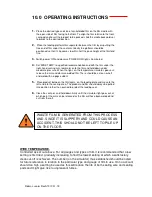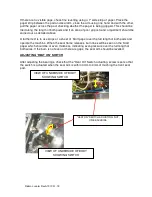
Robin L sealer RevA19 17-01-19
2. HEAT SEALING & TRIMMING
The heat sealing and cutting of plastic films inevitably gives rise to some fumes. Analysis
of the fumes generated by this process and given off from Polyolefin/Polypropylene film
indicates that under typical operation conditions no organic compounds are present in
concentrations greater than 5% of the Occupational Exposure Limits determined by the
Health & Safety Executive, with concentrations generally less than 1% of OEL. However,
even low concentrations of fumes can be irritating to sensitive persons and it is
recommended that adequate ventilation should be provided to the working area to avoid a
build-up of fumes over a period of time. It is advisable to ensure that operatives and
personnel in the working area do not have a history of respiratory or pulmonary illness and
that the sealing equipment is maintained in good and clean condition.
Attention to the cleanliness of the trim sealing heads is important as an accumulation of dirt
or melted plastic can cause excessive fuming. Running the heat control at too high a setting
can also contribute to excessive fuming and it is usually found in these circumstances that a
reduction in the heat setting, combined with increased pressure on the sealing head, will
give a better seal performance.
3. STATIC ELECTRICITY
Build-up of static electricity in rolls of plastic film may cause problems when the charge
earths by sparking. Where work involves potential fire or explosion hazards, steps should be
taken to eliminate safely the static charge and to prevent subsequent recharging during
further processing. Because of the possibility of generating and or discharging an
electrostatic charge, protective wrappings should not be removed from film rolls in areas
where the atmosphere conditions are such as to present a fire or explosion hazard.
4. SLIP
Most plastic films are high slip materials and if allowed to lie on the floor, can present a
safety hazard to pedestrians. Care should therefore be exercised to ensure that scrap off-
trims of film, are tidied away in appropriate disposal containers and not be allowed to litter
the floor.
5. DISPOSAL
Disposal of scrap film should either be through the normal trade re-use outlets, burial or
incineration. Incineration can be used for disposal where the incinerator is designed to cope
with corrosive flue gasses.
NOTE!
The Materials information set out above is based on information supplied by a manufacturer
of Polyolefin Film and is correct to the best of our knowledge and belief. However, whatever
film you decide to use, since the chemical composition may vary from manufacturer to
manufacturer, you must satisfy yourself, by reference to the material supplier, that the
material is safe to use on a heat seal and cut machine such as the ROBIN and that any
fumes given off are not toxic or harmful.
Mono Equipment does not accept any liability whatsoever for any consequences arising
from your choice of wrapping film.












































